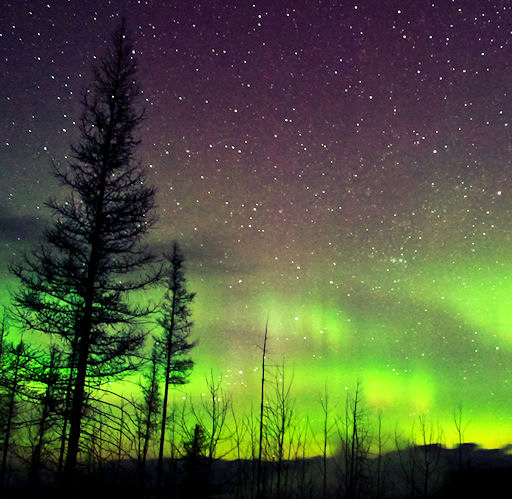SPACE ROCKS FOUND: Meteorite hunters have found fragments of the minivan-sized asteroid that exploded over California on April 22nd. Meteorites landed in the vicinity of Sutter's Mill in El Dorado County, CA, the same place gold was discovered in 1848, triggering the California Gold Rush. Astronomers plan to study the fragments to learn more about the asteroid, specificially its composition and origin. News reports: #1, #2, #3.
AURORA WATCH: Earth's magnetic field is reverberating from three days of buffeting by a high-speed solar wind stream. Since April 23rd, auroras have been photographed in more than a dozen US states including Michigan, Nebraska, Kansas, Wisconsin, North Dakota, South Dakota, Iowa, Illinois, Minnesota, Colorado, Washington, and of course Alaska. Kameron Barge sends this picture from the North Fork of the Flathead River in Glacier National Park, Montana:
More auroras may be in the offing. A minor CME is en route to Earth, due to arrive on April 26th. The impact of the cloud will add to the ongoing effect of the solar wind, boosting the chances of another display. NOAA forecasters estimate a 20% to 30% chance of geomagnetic storms during the next 24 hours. Aurora alerts: text, phone.
more images: from Zoltan Kenwell east of Edmonton, Alberta Canada; from Stephan Hoglund of Grand Marais Minesota; from Janusz Jakub Kuc of Horn Head, Co. Donegal, Ireland; from Tyler Scholle of Point no Point, Washington; from Kari Zoellner of Wasilla, Alaska
FARSIDE BLAST: For more than a week, solar activity has been low. Today, around 0600 UT, an active region on the farside of the sun broke the calm with a powerful eruption. NASA's Solar Dynamics Observatory recorded a massive cloud of plasma flying over the southwestern limb:
A coronal mass ejection emerging from the blast site will certainly miss Earth, but it might hit Mercury. Stay tuned for further analysis of the cloud's trajectory.
Would you like to inspect the farside of the sun and see the active region that exploded? Download the 3D Sun app for iPhone or Android.

![]()
Solar wind
speed: 548.2 km/sec
density: 0.0 protons/cm3
explanation | more data
Updated: Today at 1741 UT
![]()
X-ray Solar Flares
6-hr max: B5 1525 UT Apr26
24-hr: B7 0133 UT Apr26
explanation | more data
Updated: Today at: 1700 UT
![]()
![]()
![]()
Daily Sun: 26 Apr 12
![]()
![]()
The magnetic field of sunspot 1465 has relaxed, reducing the chances of strong flares from the region. Credit: SDO/HMI
![]()
![]()
![]()
Sunspot number: 137
What is the sunspot number?
Updated 25 Apr 2012
Spotless Days
Current Stretch: 0 days
2012 total: 0 days (0%)
2011 total: 2 days (<1%)
2010 total: 51 days (14%)
2009 total: 260 days (71%)
Since 2004: 821 days
Typical Solar Min: 486 days
Updated 25 Apr 2012
The Radio Sun
10.7 cm flux: 127 sfu
explanation | more data
Updated 25 Apr 2012
![]()
![]()
![]()
Current Auroral Oval:
![]()
Switch to: Europe, USA, New Zealand, Antarctica
Credit: NOAA/POES
![]()
![]()
![]()
Planetary K-index
Now: Kp= 2 quiet
24-hr max: Kp= 5 storm
explanation | more data
![]()
Interplanetary Mag. Field
Btotal: 3.8 nT
Bz: 1 nT south
explanation | more data
Updated: Today at 1746 UT
![]()
![]()
![]()
Coronal Holes: 24 Apr 12
![]()
![]()
There are no large coronal holes on the Earthside of the sun. Credit: SDO/AIA.






